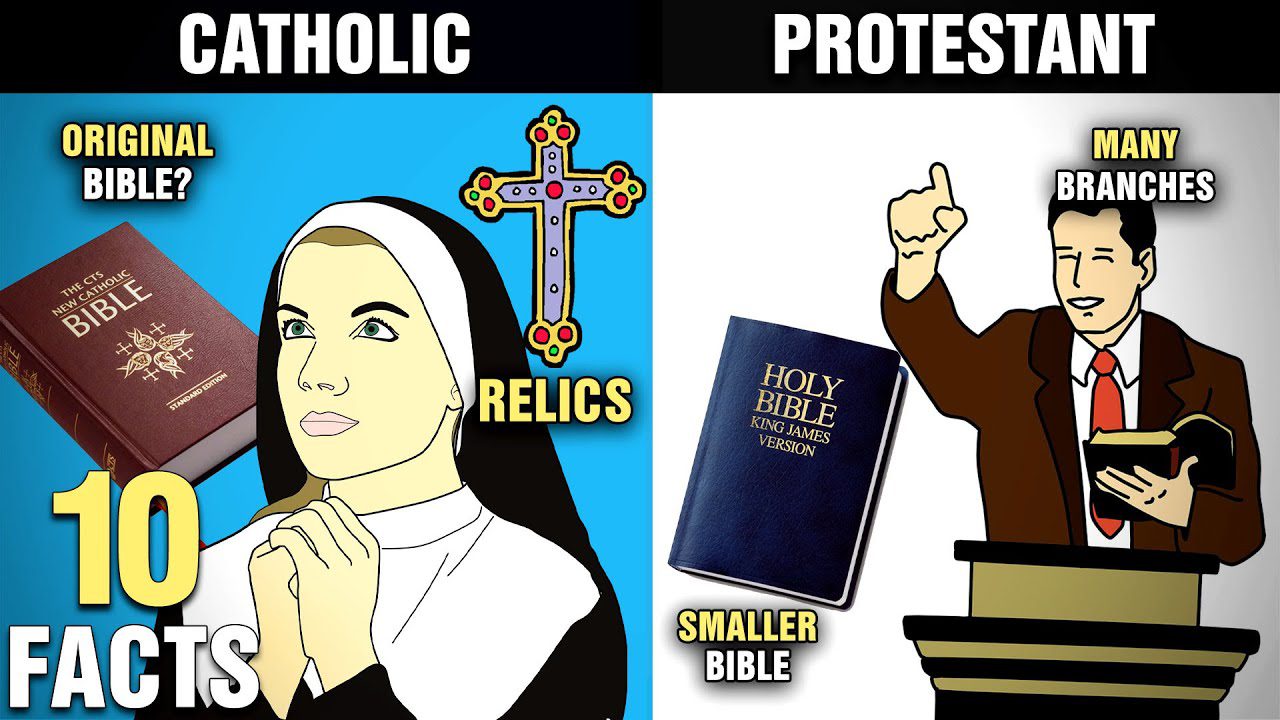Protestantism and Catholicism differ significantly in their approach to authority, the role of Mary, sacraments, purgatory, salvation, the priesthood, the Bible, tradition, icons, and church governance. Catholics accept the hierarchy of the Pope as the ultimate authority, while Protestants view the Bible as the ultimate authority. The role of Mary is central to Catholicism, while Protestants honor her role but do not focus on it as much. Catholics believe in seven sacraments, while Protestants have only two, and the Catholic Church considers these sacraments necessary for salvation. Catholics believe in the existence of purgatory, while Protestants do not. Catholics believe in salvation by works, while Protestants teach salvation by grace through faith alone. Catholicism has a hierarchical priesthood system, while Protestants believe in the general priesthood of all believers. Catholics recognize both scriptural and non-scriptural traditions, while Protestants emphasize scriptural tradition. Catholics use icons in worship, while Protestants generally do not. Finally, Catholicism operates under the Pope’s ultimate authority, while Protestant governance structures tend to have more congregational influence in determining the church’s direction.
1. Authority
One of the significant differences between Protestantism and Catholicism is how they approach authority. Catholics believe in the ultimate authority of the Pope, who they regard as the successor of St. Peter, the founder of the church. In contrast, Protestants believe that the Bible is the ultimate authority, and they reject the Pope’s teachings as infallible.
2. Role of Mary
Catholicism regards Mary as the blessed virgin, mother of Jesus Christ, and the queen of heaven. On the other hand, while Protestants also honor Mary’s role, it is not as central to their faith as it is in Catholicism. Protestants pray to God, while Catholics believe in praying through Mary, asking for her intercession.
3. Sacraments
Catholicism believes in seven sacraments, while Protestants have only two. These are Baptism and The Lord’s Supper, or Communion. The Catholic Church considers these seven sacraments necessary for salvation. Protestants, however, believe that they are symbolic acts and do not believe that these sacraments are essential for salvation.
4. Purgatory
Catholicism teaches the existence of purgatory. It is believed to be a place where souls are cleansed of their sins before being allowed into heaven. Protestants do not accept the notion of purgatory.
5. Salvation
Salvation is a fundamental concern for Christians, and their beliefs about it differ significantly. Catholics believe in the doctrine of salvation by works, requiring good deeds for a person to earn eternal life. Protestants teach the doctrine of salvation by grace through faith alone, emphasizing that God’s saving grace comes through a person’s faith in Christ, not through their works.
6. The Priesthood
Catholicism has a hierarchical priesthood system, while Protestants do not. The Catholic Church maintains a hierarchical structure, but Protestants believe in the general priesthood of all believers, whereby everyone has direct access to God without any need for intermediaries.
7. Bible
Catholicism recognizes the New and Old Testaments in the Bible, along with the deuterocanonical books, which are not part of the Protestant Bible. The Protestant Bible includes only the 66 books recognized in the Old and New Testaments.
8. Tradition
Catholicism places a high value on tradition, whereas Protestantism has a more significant emphasis on scriptural tradition. Protestants tend to regard the Bible as the ultimate authority, while Catholics believe that both scriptural and non-scriptural traditions passed down by the church over time have equal importance.
9. Icons
Catholicism uses religious images and icons in worship, while Protestants generally do not. These images include paintings, sculptures, and stained glass that depict important scenes, people, and teachings from the Bible. Some Protestants believe that using icons in religious worship can lead to idolatrous worship, so they avoid them altogether.
10. Church Governance
The governance structures of the two denominations are considerably different. Catholicism operates under the Pope’s ultimate authority, who is considered to be the Vicar of Christ on Earth. Protestants have a looser, more decentralized style of governance, with congregants having more influence in determining the direction of the church. Protestant denominations adhere to a system of checks and balances, where there is no ultimate individual authority figure.
